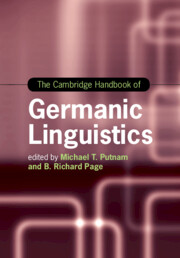Book contents
- The Cambridge Handbook of Germanic Linguistics
- Cambridge Handbooks in Language and Linguistics
- The Cambridge Handbook of Germanic Linguistics
- Copyright page
- Contents
- Figures
- Maps
- Tables
- Contributors
- Acknowledgments
- Germanic Languages
- Part I Phonology
- Part II Morphology and Agreement Systems
- Part III Syntax
- Part IV Semantics and Pragmatics
- Chapter 24 Modality in Germanic
- Chapter 25 Tense and Aspect in Germanic Languages
- Chapter 26 Prepositions and Particles
- Chapter 27 Negative and Positive Polarity Items
- Chapter 28 Grammatical Reflexes of Information Structure in Germanic Languages
- Part V Language Contact and Nonstandard Varieties
- Index
- References
Chapter 26 - Prepositions and Particles
Place and Path in English, German, and Dutch
from Part IV - Semantics and Pragmatics
Published online by Cambridge University Press: 31 March 2020
- The Cambridge Handbook of Germanic Linguistics
- Cambridge Handbooks in Language and Linguistics
- The Cambridge Handbook of Germanic Linguistics
- Copyright page
- Contents
- Figures
- Maps
- Tables
- Contributors
- Acknowledgments
- Germanic Languages
- Part I Phonology
- Part II Morphology and Agreement Systems
- Part III Syntax
- Part IV Semantics and Pragmatics
- Chapter 24 Modality in Germanic
- Chapter 25 Tense and Aspect in Germanic Languages
- Chapter 26 Prepositions and Particles
- Chapter 27 Negative and Positive Polarity Items
- Chapter 28 Grammatical Reflexes of Information Structure in Germanic Languages
- Part V Language Contact and Nonstandard Varieties
- Index
- References
Summary
Germanic languages heavily rely on prepositions and particles (‘Ps’) for describing places and paths. This category P might be considered as a small class of minor function words, but this chapter demonstrates the richness and variety of this category on the basis of Dutch, English, and German data, focusing on two of their aspects that have not received much attention in the literature: transitivity and complexity. Given that Ps are always based on a spatial relation (between a figure and a ground), it is surprising to see that they can often be used, under specific semantic conditions, without a syntactic object that expresses the ground, even as prepositions. A close look at the variation in formal complexity of Ps shows the same semantic conditions at work, revealing a basic gradient of meaning that cross-cuts the distinction between places and paths and prepositions and particles.
- Type
- Chapter
- Information
- The Cambridge Handbook of Germanic Linguistics , pp. 615 - 638Publisher: Cambridge University PressPrint publication year: 2020



